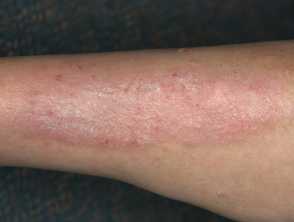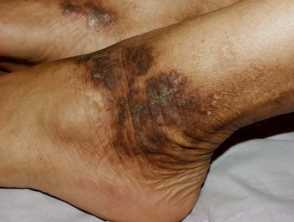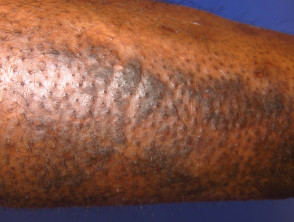What is lichen simplex?
Lichen simplex is a chronic itchy skin disorder characterised by well demarcated, erythematous patches, and plaques of thickened leathery skin.
Erythema may be variable, and lesions may be solitary or multiple. Lichen simplex is also known as neurodermatitis, lichen simplex chronicus, and neurodermatitis circumscripta.
Lichen simplex
Who gets lichen simplex?
The exact prevalence of lichen simplex chronicus is unknown, but it is relatively common and has a female preponderance with a ratio of 2:1. It most commonly occurs in mid-late adulthood, with the highest frequency in people aged 30–50 years.
Race does not appear to affect the prevalence of lichen simplex. Lichen simplex can occur in individuals with no general or other skin problems, but can occur in patients who have comorbid psychiatric conditions, primary pruritic dermatoses (particularly atopic eczema), and systemic diseases associated with pruritus.
What causes lichen simplex?
Lichen simplex results from a chronic ‘itch-scratch cycle’; following repetitive excoriation and scratching, well circumscribed thickened patches develop. The inciting stimulus for the itch can be due to a variety of reasons:
- Primary lichen simplex develops on normal skin
- Secondary lichen simplex can follow an underlying itchy dermatosis — atopic dermatitis, psoriasis, scabies, xerosis
- Neural-mediated stimulus that triggers itch — brachioradial pruritus, radiculopathy
- Systemic disease associated with pruritus — uraemia, polycythaemia vera, malignancy
- Environmental triggers — heat, sweat, chemical irritants, insect bite.
What are the clinical features of lichen simplex?
Lichen simplex chronicus consists of one or more lichenified patches or plaques on the skin. Lichenification that results from the chronic itching and scratching cycle causes an exaggeration of the normal skin marking creases giving a ‘criss-cross’ pattern. Other clinical features may include:
- Hyper- or hypopigmentation (particularly in those with darker skin colour)
- Scaly skin
- Thickened skin
- Excoriation
- Broken hairs (the brush sign), or alopecia in affected areas.
Lichen simplex can present with single or multiple lesions, often in areas that are easy to reach. They most commonly involve the:
- Neck and scalp
- Vulva, pubis, and scrotum
- Wrists and extensor forearms
- Ankles, lateral shins, and thighs.
Click here for images of lichen simplex
Click here for images of vulval lichen simplex
How do clinical features vary in differing types of skin?
Pigmentary changes, such as hyper- or hypopigmentation, are more commonly seen in patients with darker skin types; erythema is much less obvious.
What are the complications of lichen simplex?
- Hyper- or hypopigmentation
- Scarring and fibrosis
- Anxiety and psychiatric related comorbidities
- Adverse effects of medications used to treat the condition (systemic and topical corticosteroids).
How is lichen simplex diagnosed?
The diagnosis of lichen simplex chronicus is largely clinical. Investigations are performed to exclude other differential diagnosis:
- Skin biopsy
- Patch testing — used to exclude contact allergic dermatitis as the underlying dermatosis
- Fungal culture — used to investigate underlying dermatophyte or candida infection.
In order to investigate underlying conditions predisposing itch, serum TSH, free T4, EUC, LFTs, FBC, imaging, and other investigations may be undertaken.
What is the differential diagnosis for lichen simplex?
The following conditions should be excluded when evaluating patients with lichen simplex:
- Atopic dermatitis
- Psoriasis
- Lichen planus
- Contact dermatitis
- Mycosis fungoides
- Superficial basal cell carcinoma, in situ squamous cell carcinoma.
Additionally, further differentials need to be considered based on the distribution disease. For example:
- Extramammary Paget disease
- Tinea cruris.
What is the treatment for lichen simplex?
The treatment of lichen simplex can be summarised into a few key areas:
- Breaking the itch-scratch cycle
- Providing education
- Behavioural changes
- Pharmacotherapy
- Applications and procedures.
General measures
- Physical barriers and bandaging to reduce subconscious scratching.
- Reduce stress, keep nails short, wear loose-fitting clothing.
- Avoid and/or address triggers.
- Treatment of the underlying systemic condition, dermatosis, or psychiatric disorder.
- Emollients — aim for use at least twice daily; best applied after showering to retain moisture.
Specific measures
- First-generation sedating antihistamines (e.g. phenhydramine or chlorpheniramine) for those with disruptive night-time pruritus.
- Topical corticosteroids — superpotent topical corticosteroids 1–2x daily with either paste bandage or hydrocolloid occlusion for up to 4 weeks. Alternatively, a steroid impregnated tape may be used. Weaker steroids can be used in sensitive thin skin areas.
- Intralesional steroids can be used for refractory lesions.
- Coal tar preparations.
- Topical antipruritics — capsaicin or doxepin cream.
- Topical calcineurin inhibitors — tacrolimus ointment or pimecrolimus cream
- Transcutaneous electrical nerve stimulation (TENS)
- Acupuncture
- Surgical excision — may be indicated for nodular isolated lesions
- Habit reversal techniques
- Phototherapy.
What is the outcome for lichen simplex?
Lichen simplex is a chronic skin condition (hence lichen simplex chronicus). Whilst it can clear completely, it is often persistent and prone to recurrence. Treatment of the underlying condition predisposing to itch is essential to reduce recurrence in lichen simplex.
Often patients find no reprieve from lichen simplex without targeted pharmacotherapy (e.g. topical corticosteroids).


